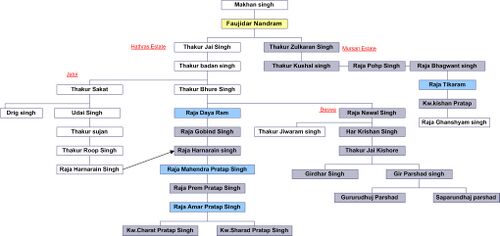Raja Daya Ram
Raja Daya Ram (r.1775-1841) was Thenua clan ruler of Hathras in Uttar Pradesh.
Genealogy of Hathras rulers
Makhan Singh → Nand Ram (r. 1645-1695) → Jai Singh → Badan Singh → Bhure Singh → Raja Daya Ram ( 1775-1841) → Thakrur Gobind Singh (1841-1861) → Raja Harnarain Singh (1861-1896) → Raja Mahendra Pratap Singh (1886-1979) → Raja Prem Pratap Singh (1913-1947) → Raja Amar Pratap Singh (b.1940)
History

Thenua Jats were the rulers of Mursan state, Hathras state, Beswan state, Vrindawan state and Baldevgarh state, all in Uttar Pradesh.
At the end of 16th century Thenuas came from Rajasthan to Brij under the leadership of Makhan Singh. They settled near Javra and occupied nearby areas. This was during the reign of Mughal ruler Jahangir. Their state was officially known as Tappa Javra.[1]
Makhan Singh - Makhan Singh married with daughter of Khokhan gotra Jats, who were in occupation of areas around Raya. After marriage Makhan Singh organized Jats of that area and gathered power. He constructed forts at Gausna (गौसना), Sindura (सिन्दूरा) etc. which were visited by historian Thakur Deshraj.[2] [3]
During the end of reign of Shahjahan, Sadulla Khan made a cantonment to control the growing power of Jats at place known as Sadabad. In 1652 AD Sadulla Khan occupied [Tappa]] - Javra of Jats, part of Jalesar, some villages of Khandoli, 80 villages of Mahavan and merged them with Sadabad pargana. This way Jats came under Mugals but they did not pay any Tax. [4]
Nand Ram (r. 1645 -1695) - After Shahjahan, Makhan Singh's grandson Nand Ram again organized the Jat power and became strong by merging Porcha Raja of Dariyapur with him. When Aurangzeb became the ruler of Delhi he could not ignore Nand Ram and awarded him the title of Faujdar and handed over Tochhigarh tahsil to him. Nand Ram ruled tactfully and bravely for 40 years and died in 1695. [5]
Nandram had 14 sons out of them Jalkaran was eldest. Second son was Jai Singh, seventh son was Bhoj Sing, 8th son was Churaman, 9th son was Jaswant Singh, 10th Adhikaran, 11th Vijay Singh. Churaman ruled Tochhigarh. Jaswant Singh ruled Bahramgarhi. Jalkaran died before Nandram. His able son Kushal Singh became successor.
Thakur Kushal Singh - Kushal Singh got villages Rahatpur and Makrol from his uncle Bhoj Singh. Kushal Singh won Dayalpur, Mursan, Gopi, Putaini, Ahri, and Baramai areas from Sa'adat Ullakhan. The famous fort of Mursan was constructed by Kushal Singh. He had enhanced his power over large areas like Mathura, Hathras and Aligarh. [6]
Puhap Singh - After Kushal Singh his son Puhap Singh became the ruler. Puhap Singh lost war with Bharatpur. He had to leave Mursan and went to Sasni and occupied it. He constructed a strong fort here. Sasni is known as a a fort of Jat pride. In 1761 he accepted rule of Maharaja Jawahar Singh of Bharatpur and given back Mursan in friendship. Puhap Singh did great help to Jawahar Singh in Delhi war. As a result it annoyed the Delhi rulers. Delhi ruler Najib Khan sent his army to attack Mursan. Jats fought bravely but had to leave Mursan. Puhap Singh struggled for 10 years to get back Mursan. He succeeded in 1785 to get back Mursan. He continued to expand till his death in 1798. [7]
As said earlier out of 14 sons of Nandram, two were more famous: Jalkaran Singh and Jai Singh. Jalkaran's grandson was Raja Bhagwant Singh, who was ruler of Sasni and Mursan. Jai Singh's grandson was Daya Ram, who became ruler of Hathras. Bhagwant Singh later helped Lord Lake and got Sonkh and Madan in Jagir. According to Mathura Memoirs, the rulers of Mursan and Hathras considered them selves Independent. In 1817 Mursan and Hathras forts fell to British under General Marshal. Raja Daya Ram thought it appropriate to have a treaty with British rule. [8]
Raja Daya Ram (1775-1841) - After the death of Thakur Bhuri Singh 1n 1775,his son Daya Ram ascended the throne of Hathras. He was a astute ruler and was well versed in the literary circles. He was the first to assume the title of Raja of Hathras. Historians credit him to have brought the all round progress and prosperity of Hathras as a state. He expanded territories Hathras which in his time included Simardhari, Tochhigarh, Gubrari, Barhad, Karas, Karil, Mant, Mahaban, Hasangarh, Sahapau and Khandoli towards Agra. He was considered along with Raja of Mursan Raja Bhagwant Singh were considered the most powerful chiefs in this part of the country by the Britishers. Hathras was said to be the strongest fort in the country.
References
- ↑ Thakur Deshraj:Jat Itihas, p. 563
- ↑ Thakur Deshraj:Jat Itihas, p. 563
- ↑ Mahendra Singh Arya et al: Adhunik Jat Itihas,
- ↑ Thakur Deshraj:Jat Itihas, p. 563
- ↑ Thakur Deshraj:Jat Itihas, p. 564
- ↑ Thakur Deshraj:Jat Itihas, p. 564
- ↑ Thakur Deshraj:Jat Itihas, p. 564-65
- ↑ Thakur Deshraj: Jat Itihas, p. 567-68
Back to The Rulers

